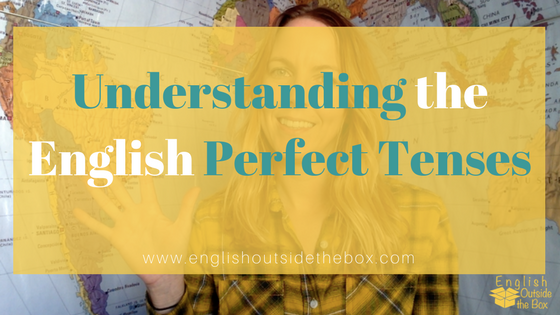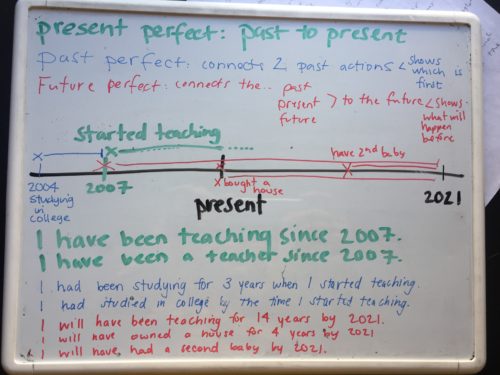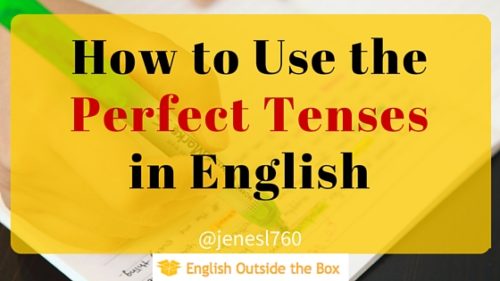
Understanding the English Perfect Tenses
From time to time I ask my Instagram students what they need and want to learn. Sometimes I’ll ask which specific questions they have, or ask them to share which topics they want more of (whether it’s grammar, vocabulary, writing, etc…). There is usually a pattern, English learners are confused and want a better understanding of the English perfect tenses, and they want more grammar.
I love grammar and teaching grammar, so this works for me! This is why I’ve dedicated today’s lesson to those things. I have written an English lesson about the perfect tenses in the past, but I wanted to provide some more information about this confusing grammar point today, as well as include a 5 Minute English video. If you missed the previous lesson about the perfect tenses, you can read that here, or bookmark it to read later.
We’ll begin the lesson today with your video. Practice note-taking and listening comprehension while you hear all about the perfect tenses in English. When the video ends, continue reading this post for more explanations, sentences, and visuals!
Let’s go!
Understanding the English Perfect Tenses
The English perfect tenses (present perfect, present perfect progressive/continuous, past perfect, past perfect progressive/continuous, future perfect, & future perfect progressive/continuous) are all used to make connections in time. Each of these tenses helps your listener (or reader) understand the verbs you’re using because they make these connections within time, showing which actions happened first, if they’re still happening, etc…
*NOTE: the terms “progressive” and “continuous” mean the same thing. This post will use the term, “continuous”
What are the Perfect Tenses?
The perfect Tenses all include a form of the auxiliary HAVE and the past participle. The progressive tenses always have the past participle of BE and the main verb in the -ING form. Here’s a review of each of the sentence structures:
present perfect: subject + has/have + past participle (+ object) → I have lived in Brazil. He has eaten sushi.
present perfect continuous: subject + has/have + been + verb-ING (+ object) → I have been teaching for 10 years. She has been living there since 2004.
past perfect: subject + had + past participle (+ object) → They had seen her before yesterday.
past perfect continuous: subject + had + been + verb-ING (+ object) → We had been dating a long time when we got married.
future perfect: subject + will + have + past participle (+ object) → I will have gotten my Master’s degree by then.
future perfect continuous: subject + will + have + been + verb-ING (+ object) → They will have been traveling for 3 months by the end of the year.
Connections in Time:
As I mentioned the perfect tenses all make connections in time. Specifically…
- the present perfect connects the past to the present (and shows experience)
- the past perfect connects 2 past actions (or a past action and a past time), and shows which happened first
- the future perfect connects a past, present, or future action with a time (or action) in the future, and it shows which will happen before that future time
The main difference between the simple and continuous tenses is that the simple perfect tenses focus on a result (something finishing), and the continuous tenses focus on duration (something continuing).
Let’s review with some more detail!
This was the whiteboard used in the video, and for the sentence examples below. Use it a support visual to “see” the connections made with the time tenses
Present Perfect & Present Perfect Continuous
This tense is the most common! You are going to use this to talk about experiences (things you’ve done in the past, at an unspecified time), and that are true today! You’ll use this when introducing yourself, having a conversation with others about you, and in many different types of conversations. These 2 tenses will help you emphasize that actions are still happening, or still true today.
I started teaching in the past, in 2007. Because today the year is 2017, I can connect the past to the present by saying:
I have been teaching for 10 years.
I have been a teacher since 2007.
Remember, the present perfect continuous focuses on duration, or something continuing. With this tense, I am emphasizing that continuing action (rather than a finished result). In my second example (I have been a teacher…), the main verb is BE, which is a non-action or stative verb. Non-action verbs can never be in the -ING form, so that’s why it’s in the [simple] present perfect tense. We use the [simple] present perfect to show continuation with stative verbs only. If you need more information about non-action/stative verbs, I suggest reading this post here.
The simple present perfect is usually only used to show experience though. For example, I have lived in Brazil. This means I have the experience of living in Brazil.
Past Perfect & Past Perfect Continuous
The past perfect tense, while not the most common, is still very, very important! You will use this tense when talking about the past, especially when telling past stories. Because it helps connect actions in the past, and tells which happened first, it will help your listener understand the order of events.
I started studying in college in 2004. This action happened before another past action of starting to teach in 2007. So, I can connect two past events by saying:
I had been studying for 3 years when I started teaching.
I had studied in college by the time I started teaching.
Both of the actions in the past perfect tenses (had been studying & had studied) show that they happened 1st, BEFORE the 2nd action of starting to teach. Remember that the main difference between these two examples is that the continuous tense focuses on continuation/duration, and the simple tense focuses on an action finishing/the result.
As I mentioned we can connect 2 past actions like my examples above (studying & teaching), or we can connect a past action with a past time:
I had been studying for 3 years by 2007
I had studied in college by 2007.
Future Perfect & Future Perfect Continuous
The future perfect will give that same connection, showing what you will have done before a future time or event. I find this tense to be the most common in job settings, when talking about experience you will have or projects you will have completed by some future time. However, you can also use this in conversations when talking about future plans and goals.
I started teaching in 2007. If I wanted to connect this past action, to the future (the year 2021), then I can do this by saying:
I will have been teaching for 14 years by 2021.
*I will have graduated college by 2021.
(( ↑ This is an example of the [simple] future perfect showing an action will have been finished by a future time, focusing on the result.))
Let’s imagine that I bought a house today (in 2017). That would make it a present tense action. I can connect the present to the future by saying:
I will have owned a house for 4 years by 2021.
(( ↑ This is an example of a stative verb (OWN) showing continuation with the simple future perfect.))
I will have been living in my new (owned) home for 4 years by 2021.
(( ↑ This focuses on continuation with the future perfect continuous.))
Finally, we can connect the future to the future. So I know (it’s a pretty for sure plan) that I will have a second baby before 2021. I can express this by saying:
I will have had a second baby by 2021.
(( ↑ This focuses on a result happening before a future event))
Practice Makes Perfect
Now that you have a better understanding of the English perfect tenses, it’s time to practice! The most important thing that you can do is try and make this information relevant to you. If you connect this grammar to you personally, then you are more likely to remember the information and be able to use it in your conversations in the future.
So can you create your own timeline with some past, present, and future actions and times?
You can draw this on a piece of paper and then write out some sentence examples focusing on the correct structures and uses.
Additionally, you can answer the following questions:
- What is something you have been doing since last year?
- Had you already been learning English with my videos before you started this lesson?
- By the end of the year, how long will you have been studying English?
The great news is, there is EVEN MORE practice activities on this blog lesson here. Check it out and take your learning even further!
I hope this helps you improve your English skills today, and don’t forget to comment below with your sentences, question answers, or examples to practice! You can participate by commenting below!
Until next time,
Happy Studying! ♥
If you know someone learning English, please help me …help them and share this article on Facebook, Instagram, Pinterest or Email! Thank you!



Thank you for a PERFECT explanation!
hello !
Do you know why simple and continuous tenses are typically taught to beginner-level ESL students before the perfect tenses ?
Thank you.
It’s a less complex tense and used more often.
Thanks, you are a good teacher and you explained very simple. I know all of them step by step.
This is the best explanation of the perfect tenses I have ever seen. You are a genius teacher! Thanks
[…] This sentence structure is a negative form of the present perfect. “Have not” is an auxiliary of the present perfect tense, and it’s used to say that you don’t have the experience of doing something, or you have not (yet) finished an action. (*read more about the present perfect by clicking here.) […]
Very good and interesting